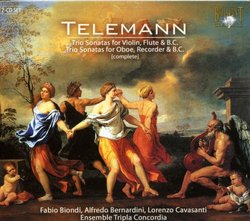| All Artists: Georg Philipp Telemann, Tripla Concordia Title: Telemann: Complete Trio Sonatas for Violin, Flute & B.C.; Complete Trio Sonatas for Oboe, Recorder & B.C. Members Wishing: 0 Total Copies: 0 Label: Brilliant Classics Original Release Date: 1/1/2009 Re-Release Date: 2/10/2009 Genres: Pop, Classical Styles: Vocal Pop, Opera & Classical Vocal, Chamber Music, Historical Periods, Classical (c.1770-1830) Number of Discs: 2 SwapaCD Credits: 2 UPCs: 842977038736, 5028421938738 |
Search - Georg Philipp Telemann, Tripla Concordia :: Telemann: Complete Trio Sonatas for Violin, Flute & B.C.; Complete Trio Sonatas for Oboe, Recorder & B.C.
 | Georg Philipp Telemann, Tripla Concordia Telemann: Complete Trio Sonatas for Violin, Flute & B.C.; Complete Trio Sonatas for Oboe, Recorder & B.C. Genres: Pop, Classical
|
Larger Image |
CD Details |
CD ReviewsPulse-raising Telemann trio sonatas by Tripla Concordia Frank T. Manheim | Fairfax VA | 07/07/2009 (5 out of 5 stars) "Some may think of trio sonatas as esoteric music for deep-dyed baroque music lovers or musicologists. Not this Telemann by Tripla Concordia! The driving, pulse-pounding opening allegro from the Trio Sonata in D for violin, flute & continuo (cello-harpsichord) will quickly put aside the idea of pleasant background music.
The best way to listen to these trio sonatas is with either with a good stereo system at concert volume, or with good stereo earphones at a time when other distractions don't interfere (I'll give an additional technical reason besides getting full enjoyment in a minute). The way the full-blooded Italian Tripla Concordia group commits itself to the fast movements makes it virtually impossible to not become riveted to the music. Tripla Founder Lorenzo Cavasanti (recorder, flute), baroque violinist Fabio Biondi, and others in the ensemble all have impeccable period instrument professional and international performance and recording credentials. But they make clear how far early music can come from mannered and stylized performance in their non-stuffy liner notes and in their playing. It has come to be better understood in recent years how profoundly the 23-year old Telemann was influenced by his travel through the Tatra Mountains in the company of his first employer, 21-year old Count Erdmann von Promnitz. Telemann mentions in his first autobiography of 1718 how dazzled he was with the wild musicmaking of Polish mountain bagpipers and folk fiddlers. Throughout his career Telemann took inspiration from this music when he wanted to raise audience or performer blood pressure. I compare it to Haydn, Mozart, and many other later composers' use of Hungarian gypsy music to spice up their compositions. My main reservation with the recording is that the violin and cello (and harpsichord) are miked too low to provide adequate volume to hear Fabio Biondi's brilliant violin playing, and to bring out the bass part (cello). Unlike many other Baroque composers, Telemann took special care and pride in giving the bass in trio sonatas meaningful parts that would play an integral, and "inevitable-sounding" role in the ensemble sound. To get full appreciation of the pieces I had to listen with at least concert-level sound volume and concentrate on hearing the lower strings and harpsichord. To avoid misunderstanding note that the "Complete trio sonatas", refers only to the combinations for violin, flute and basso continuo, and oboe, recorder, and bc, not all Telemann's trio sonatas." |

 Track Listings (24) - Disc #1
Track Listings (24) - Disc #1